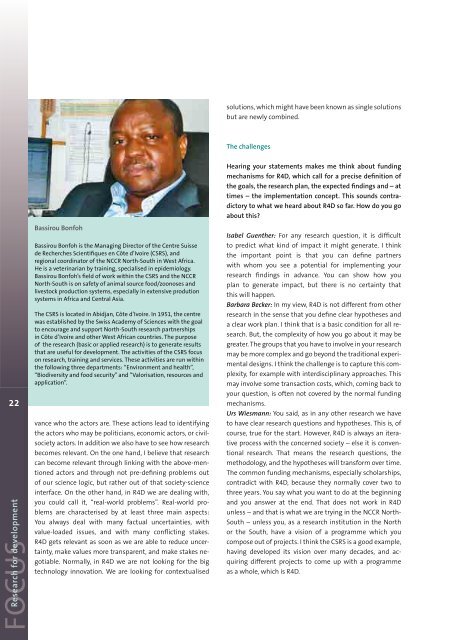NORTH-SOUTH CENTRE - ETH - North-South Centre North-South ...
NORTH-SOUTH CENTRE - ETH - North-South Centre North-South ...
NORTH-SOUTH CENTRE - ETH - North-South Centre North-South ...
Create successful ePaper yourself
Turn your PDF publications into a flip-book with our unique Google optimized e-Paper software.
solutions, which might have been known as single solutions<br />
but are newly combined.<br />
The challenges<br />
22<br />
FOCUS<br />
Research for development<br />
Bassirou Bonfoh<br />
Bassirou Bonfoh is the Managing Director of the <strong>Centre</strong> Suisse<br />
de Recherches Scientifiques en Côte d’Ivoire (CSRS), and<br />
regional coordinator of the NCCR <strong>North</strong>-<strong>South</strong> in West Africa.<br />
He is a veterinarian by training, specialised in epidemiology.<br />
Bassirou Bonfoh’s field of work within the CSRS and the NCCR<br />
<strong>North</strong>-<strong>South</strong> is on safety of animal source food/zoonoses and<br />
livestock production systems, especially in extensive prodution<br />
systems in Africa and Central Asia.<br />
The CSRS is located in Abidjan, Côte d’Ivoire. In 1951, the centre<br />
was established by the Swiss Academy of Sciences with the goal<br />
to encourage and support <strong>North</strong>-<strong>South</strong> research partnerships<br />
in Côte d’Ivoire and other West African countries. The purpose<br />
of the research (basic or applied research) is to generate results<br />
that are useful for development. The activities of the CSRS focus<br />
on research, training and services. These activities are run within<br />
the following three departments: “Environment and health”,<br />
“Biodiversity and food security” and “Valorisation, resources and<br />
application”.<br />
vance who the actors are. These actions lead to identifying<br />
the actors who may be politicians, economic actors, or civilsociety<br />
actors. In addition we also have to see how research<br />
becomes relevant. On the one hand, I believe that research<br />
can become relevant through linking with the above-mentioned<br />
actors and through not pre-defining problems out<br />
of our science logic, but rather out of that society-science<br />
interface. On the other hand, in R4D we are dealing with,<br />
you could call it, “real-world problems”. Real-world problems<br />
are characterised by at least three main aspects:<br />
You always deal with many factual uncertainties, with<br />
value-loaded issues, and with many conflicting stakes.<br />
R4D gets relevant as soon as we are able to reduce uncertainty,<br />
make values more transparent, and make stakes negotiable.<br />
Normally, in R4D we are not looking for the big<br />
technology innovation. We are looking for contextualised<br />
Hearing your statements makes me think about funding<br />
mechanisms for R4D, which call for a precise definition of<br />
the goals, the research plan, the expected findings and – at<br />
times – the implementation concept. This sounds contradictory<br />
to what we heard about R4D so far. How do you go<br />
about this?<br />
Isabel Guenther: For any research question, it is difficult<br />
to predict what kind of impact it might generate. I think<br />
the important point is that you can define partners<br />
with whom you see a potential for implementing your<br />
research findings in advance. You can show how you<br />
plan to generate impact, but there is no certainty that<br />
this will happen.<br />
Barbara Becker: In my view, R4D is not different from other<br />
research in the sense that you define clear hypotheses and<br />
a clear work plan. I think that is a basic condition for all research.<br />
But, the complexity of how you go about it may be<br />
greater. The groups that you have to involve in your research<br />
may be more complex and go beyond the traditional experimental<br />
designs. I think the challenge is to capture this complexity,<br />
for example with interdisciplinary approaches. This<br />
may involve some transaction costs, which, coming back to<br />
your question, is often not covered by the normal funding<br />
mechanisms.<br />
Urs Wiesmann: You said, as in any other research we have<br />
to have clear research questions and hypotheses. This is, of<br />
course, true for the start. However, R4D is always an iterative<br />
process with the concerned society – else it is conventional<br />
research. That means the research questions, the<br />
methodology, and the hypotheses will transform over time.<br />
The common funding mechanisms, especially scholarships,<br />
contradict with R4D, because they normally cover two to<br />
three years. You say what you want to do at the beginning<br />
and you answer at the end. That does not work in R4D<br />
unless – and that is what we are trying in the NCCR <strong>North</strong>-<br />
<strong>South</strong> – unless you, as a research institution in the <strong>North</strong><br />
or the <strong>South</strong>, have a vision of a programme which you<br />
compose out of projects. I think the CSRS is a good example,<br />
having developed its vision over many decades, and acquiring<br />
different projects to come up with a programme<br />
as a whole, which is R4D.
















